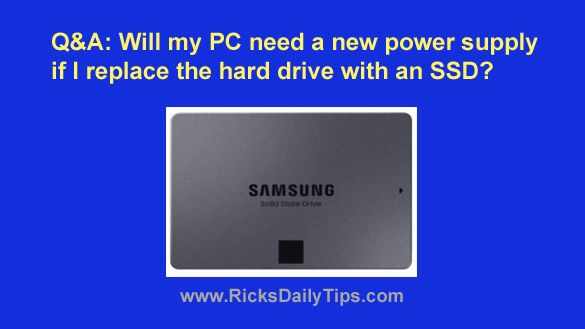 Question from Oliver: I just read your article about replacing a hard drive with an SSD and I have a question about it.
Question from Oliver: I just read your article about replacing a hard drive with an SSD and I have a question about it.
I remember hearing that upgrading the graphics card in a computer can sometimes require a power supply upgrade as well because the newer graphics card will draw more power than the old one.
My question is do I need to be concerned about the power supply if I replace the hard drive in my computer with an SSD?
This is a pretty old machine and I don’t know if the power supply is up to the task of powering an SSD. I don’t want to burn it up or damage anything by over-loading the power supply.
Rick’s answer: You should be able to safely replace the hard drive in your PC with an SSD with no worries at all, Oliver.
SSDs typically draw less current from a computer’s power supply than spinning hard drives, therefore the power supply that’s already powering the hard drive should easily handle the power requirements of a new SSD.
Of course that answer assumes that you’re truly going to replace the hard drive with the SSD instead of adding the SSD as a second drive.
Adding a new drive to a computer system without removing one will indeed increase the overall load on the machine’s power supply, but that’s only a problem in situations where the power supply is already being pushed to the max.
If you have added new (as in additional) hardware devices to your computer at some point in the past there’s always a chance that the power supply might not be able to handle another additional device.
However, this shouldn’t be an issue in your case since you’ll be removing the hard drive and installing the SSD in its place.
I hope this helps, Oliver. Good luck!
Bonus tip: You mentioned that your computer is pretty old. Would you like to speed it up as much as possible without laying out any additional cash?
If so, you might want to consider replacing its Windows installation with Linux since Linux almost always runs faster than Windows on the same hardware. Just something to consider…